- Scientific name: Cardamine dentata Schult.
- Synonymy: Cardamine pratensis var. palustris Wimm. & Grab.
- Threatened (MA Endangered Species Act)
Description
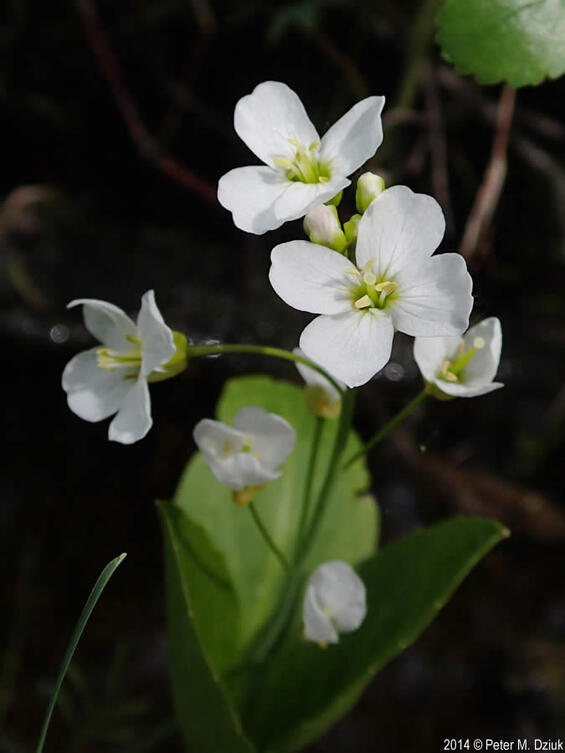
Fen Cuckoo-flower, view of open flowers. Photo by Peter M. Dziuk, MinnesotaWildflowers.info
Fen cuckoo-flower (Cardamine dentata), a member of the mustard family (Brassicaceae), is a pure white-flowered, fibrous-rooted, herbaceous perennial. The 20-51 cm (0.66-1.66 ft) long, erect stem rises from a short rhizome (a horizontal, underground stem). Its leaves are pinnately compound (divided into leaflets arranged on both sides of a common axis) and of two types. The basal leaves have long petioles (leaf stems) and have three to eight broadly oval leaflets, the terminal leaflet being the largest (see photo 3). In contrast, the cauline leaves (growing out from the stem) have narrow, roughly elliptical leaflets. On the middle and upper cauline leaves, the side-leaflets are contracted into short stalks (see photo 4). The flowers, like all flowers in the mustard family, have four separate petals arranged in the shape of a cross or crucifix (photo 1). Fen cuckoo-flower’s fruit is a linear, 2.5-4 cm (1 – 1 ½ in) long pod called a silique (one of the two fruits characteristic of the mustard family and consisting of two seed-bearing compartments or carpels, both of which fall away to leave a persistent internal partition).
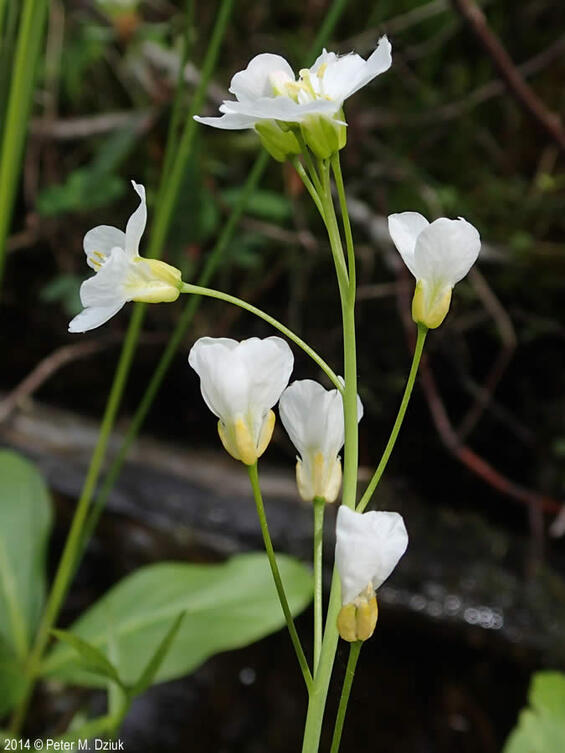
Fen Cuckoo-flower, side view of plant in bloom. Photo by Peter M. Dziuk, MinnesotaWildflowers.info
Similar species include Pennsylvania bitter cress (Cardamine pensylvanica), small-flowered bitter cress (C. parviflora) and European cuckoo-flower (Cardamine pratensis). Unlike fen cuckoo-flower, however, the leaflets on the cauline leaves of Pennsylvania bitter cress are usually decurrent (their bases extend down and fuse with the leaf axis). Both Pennsylvania bitter cress and small-flowered bitter cress have shorter petals than fen cuckoo-flower; the petals of small-flowered bitter cress are only 2-4 mm (2/25 – 4/25 in) long, compared to 6-16 mm (6/25 -16/25 in) in fen cuckoo-flower. European cuckoo-flower is the most similar to fen cuckoo-flower, and the two may be hybridizing. The primary difference is that European cuckoo-flower has a pink flower, or sometimes a white flower which fades to light pink. A technical manual should be consulted for additional differences when the plants are not in flower.
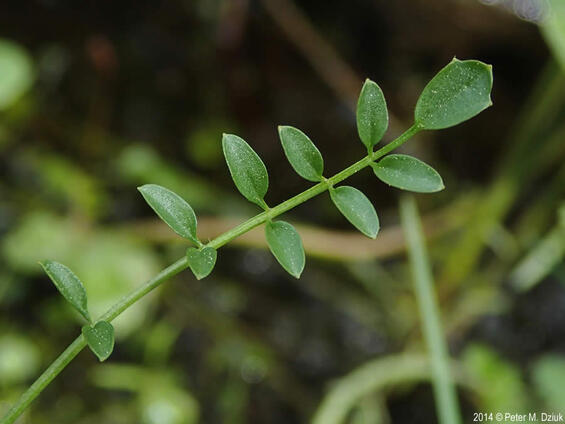
Fen Cuckoo-flower, lower stem leaf. Photo by Peter M. Dziuk, MinnesotaWildflowers.info
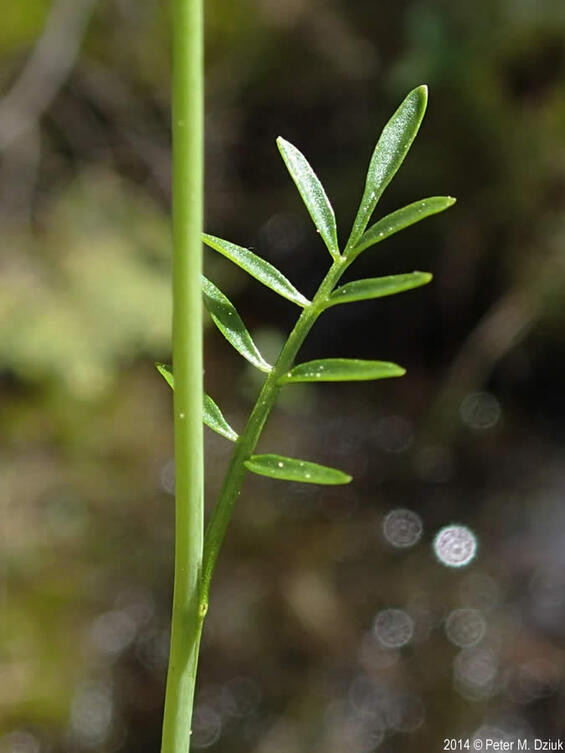
Fen Cuckoo-flower, upper stem leaf. Photo by Peter M. Dziuk, MinnesotaWildflowers.info
Life cycle and behavior
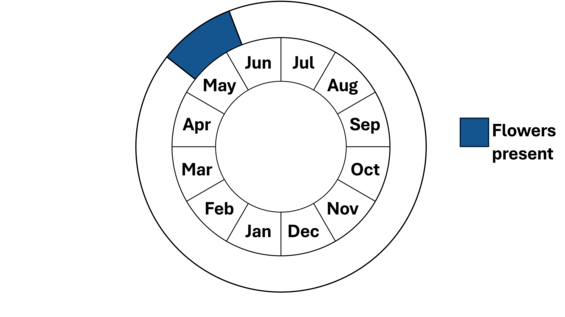
As noted above, fen cuckoo-flower is an herbaceous perennial. Fen cuckoo-flower flowers from mid-May through mid-June. Mature fruits are rarely observed as they mature quickly after flowering and drop off in early July.
Population status
Fen cuckoo-flower is listed under the Massachusetts Endangered Species Act as Threatened. All listed species are legally protected from killing, collection, possession, or sale, and from activities that would destroy habitat and thus directly or indirectly cause mortality or disrupt critical behaviors. There are three current populations (discovered or relocated since 1999) of fen cuckoo-flower in Massachusetts. None of the populations are doing particularly well, and one was not found during a recent survey. The populations occur in Berkshire and Hampden counties. An additional six populations have not been relocated recently, including one observed in Essex County.
Distribution and abundance
According to NatureServe Explorer (2025), the range of fen cuckoo-flower is disjunct across boreal Canada from Nova Scotia to Alberta, south to northern Wisconsin, northeastern Illinois, Indiana, Pennsylvania, and Virginia. It is listed as rare in almost every state where it occurs. The Biota of North America Program’s (BONAP) North American Plant Atlas (2013) illustrates the species as less disjunct but extending only as far west as Ohio and south only to Pennsylvania. In New England, fen cuckoo-flower is known from Connecticut, Massachusetts, and Vermont. It is thought to be extirpated from Connecticut and is critically imperiled in both Massachusetts and Vermont. Fen cuckoo-flower is frequently confused with European cuckoo-flower (Cardamine pratensis), an introduced species, with similar leaves but pink flowers.
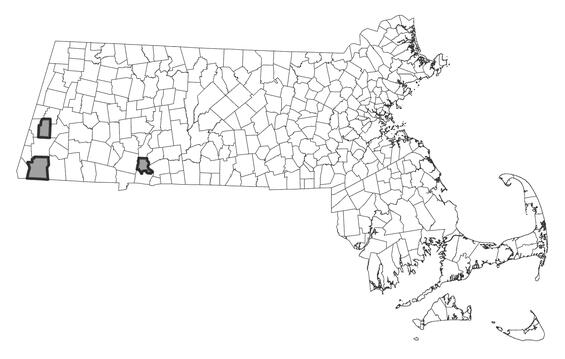
Distribution in Massachusetts
2000-2025
Based on records in the Natural Heritage Database
Habitat
The habitats of fen cuckoo-flower in Massachusetts include open portions of alkaline fens (unforested, peat-forming areas where very cold, nutrient-poor water seeps up to the surface through limey gravel), and calcareous seepage swamps. Among its associated species are red maple (Acer rubrum), speckled alder (Alnus incana), larch (Larix laricina), black ash (Fraxinus nigra), highbush blueberry (Vaccinium corymbosum), spicebush (Lindera benzoin), spring cress (Cardamine bulbosa), tussock sedge (Carex stricta), sensitive fern (Onoclea sensibilis), various willows (Salix spp.), skunk cabbage (Symplocarpus foetidus), and Sphagnum moss.
Healthy habitats are vital for supporting native wildlife and plants. Explore habitats and learn about conservation and restoration in Massachusetts.
Threats
Fen cuckoo-flower is a northern species. Although it is previously known to have occurred in Connecticut, it is now considered extirpated there. Massachusetts populations occurring in southern Berkshire County are struggling. The warming and changing climate may be one factor in this species decline in Massachusetts (Staudinger et al. 2024). Another factor may be interbreeding between this rare species and the introduced European cuckoo-flower. Other potential threats to these plants include logging, development, invasive plants shading, and crowding out this rare plant. and beavers damming fen streams.
Conservation
Survey and monitoring
Survey efforts to relocate and monitor this species in Massachusetts are needed, along with evaluation of its habitat. The best time to survey is when the plants are in bloom in May. Surveys of non-blooming plants cannot be accepted as it is very difficult to distinguish fen cuckoo-flower from the European cuckoo-flower without observing the petal color of flowers.
Management
All the current populations may need some work controlling invasive plant species threatening the populations. Beavers damming the streams are an additional threat to these populations and beaver deceiver installations may be needed to protect the populations. All active management of rare plant populations (including invasive species removal) is subject to review under the Massachusetts Endangered Species Act and should be planned in close consultation with the MassWildlife’s Natural Heritage & Endangered Species Program.
Research needs
NatureServe Explorer (2025) has the following comment regarding the taxonomy of this species:
“Taxonomic Comments: Cardamine dentata as recognized by Haines (2011) and Weakley et al. (2023) is equivalent in concept to C. pratensis var. palustris of Gleason and Cronquist (1991) and is native to North America per Weakley et al. FNA (2010, vol. 7) does not specifically recognize C. dentata but says "The taxonomy of Cardamine pratensis in North America requires further detailed study. Most, if not all, populations of this species were introduced from Europe. Some specimens resemble the European C. dentata Schultes (high polyploid, characterized by all leaves, including distalmost, pinnate with petiolate and sometimes deciduous leaflets) and these populations might be native." Kartesz (1999) includes C. pratensis var. palustris in the synonymy of C. pratensis var. pratensis.”
Clearly, genetic work on fen cuckoo-flower and the related C. pratensis is needed.
References
Al-Shehbaz, Ihsan A., Karol Marhold, Judita Lihová. Cardamine. In: Flora of North America Editorial Committee, eds. Flora of North America North of Mexico. 19+ vols. New York and Oxford. Vol. 7, pp. 482-483. https://floranorthamerica.org/Cardamine_pratensis accessed 3/3/2025.
Gleason, Henry A., and Arthur Cronquist. Manual of Vascular Plants of Northeastern United States and Adjacent Canada, Second Edition. Bronx, NY: The New York Botanical Garden, 1991.
Haines, Arthur. Flora Novae Angliae. New England Wild Flower Society, Yale University Press, New Haven, CT. 2011.
Kartesz, J.T., The Biota of North America Program (BONAP). 2015. North American Plant Atlas. (http://bonap.net/napa). Chapel Hill, N.C. [maps generated from Kartesz, J.T. 2015. Floristic Synthesis of North America, Version 1.0. Biota of North America Program (BONAP). (in press)]. https://bonap.net/Napa/TaxonMaps/Genus/County/Cardamine Accessed 3/3/2025.
Native Plant Trust. 2014. NORM Phenology Information.
NatureServe. 2025. NatureServe Network Biodiversity Location Data accessed through NatureServe Explorer [web application]. NatureServe, Arlington, Virginia. Available https://explorer.natureserve.org/. Accessed: 3/3/2025.
POWO (2025). "Plants of the World Online. Facilitated by the Royal Botanic Gardens, Kew. Published on the Internet; https://powo.science.kew.org/ Retrieved 03 March 2025."
Seymour, Frank C. 1969. The Flora of New England, First edition. Charles E. Tuttle Company, Inc. Tokyo, Japan.
Staudinger, M.D., A.V. Karmalkar, K. Terwilliger, K. Burgio, A. Lubeck, H. Higgins, T. Rice, T.L. Morelli, A. D'Amato. 2024. A regional synthesis of climate data to inform the 2025 State Wildlife Action Plans in the Northeast U.S. DOI Northeast Climate Adaptation Science Center Cooperator Report. 406 p. https://doi.org/10.21429/t352-9q86
Voss, Edward G. and Anton A. Reznicek. 2012. Field Manual of Michigan Flora. The University of Michigan Press, Ann Arbor, Michigan.
Weakley, A.S. 2020. Flora of the Southeastern United States. University of North Carolina Herbarium, North Carolina Botanical Garden, Chapel Hill, NC
Contact
| Date published: | March 25, 2025 |
|---|